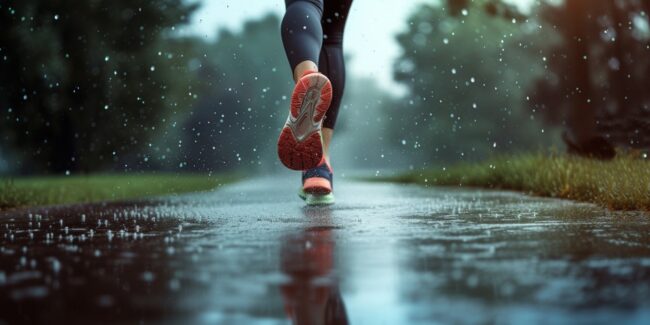Kevin Morgan of Rochester, NY, understands that training for races like the Ironman Triathlon and marathons requires dedication and adaptability, especially when dealing with varying weather conditions. With the changing seasons, athletes must be prepared to adjust their training routines to ensure safety and maximize performance. Here are Kevin’s strategies for training in heat, cold, and rain, enabling you to maintain your training schedule and achieve your goals regardless of the weather.
Training in the Heat
1. Hydration is Key: Kevin emphasizes the importance of staying hydrated before, during, and after workouts. In hot weather, your body loses more fluids through sweat, making it essential to replenish those lost fluids to avoid dehydration. Kevin recommends drinking water regularly and incorporating electrolytes to maintain the body’s salt balance.
2. Timing Your Workouts: To avoid the peak heat of the day, Kevin suggests scheduling your workouts early in the morning or later in the evening. These times are typically cooler and reduce the risk of heat-related illnesses.
3. Wear Appropriate Clothing: Lightweight, breathable, and moisture-wicking fabrics are crucial for training in hot weather. Kevin advises wearing light-colored clothing that reflects sunlight and using hats or visors to protect your face from direct sun exposure.
4. Acclimate Gradually: Kevin advises gradually acclimating your body to the heat. Start with shorter, less intense workouts and slowly increase the duration and intensity as your body adapts to the warmer temperatures. This helps prevent heat exhaustion and allows your body to adjust to the increased stress of training in the heat.
5. Listen to Your Body: It’s essential to pay attention to your body’s signals. Kevin stresses that if you experience dizziness, nausea, or extreme fatigue, it’s crucial to immediately stop exercising and find a cool place to rest and hydrate.
Training in the Cold
1. Dress in Layers: Kevin Morgan of Rochester, NY, knows that layering is vital for cold weather training. Always start with a moisture-wicking base layer to keep sweat off your skin, add an insulating layer for warmth, and top it off with a windproof and waterproof outer layer to protect against the elements.
2. Protect Your Extremities: In cold weather, your extremities are more susceptible to frostbite. Kevin recommends wearing gloves, thermal socks, and a hat or headband to keep your hands, feet, and head warm.
3. Warm Up Properly: A thorough warm-up is even more crucial when it’s cold out. Kevin suggests spending extra time on dynamic stretches and light exercises to increase your body temperature and prepare your muscles for the workout ahead.
4. Stay Visible: Winter months often mean shorter daylight hours and lower visibility. Kevin advises wearing reflective clothing and using lights or reflective gear to ensure you are visible to others, especially when running or cycling on roads.
5. Adjust Your Expectations: Cold weather can affect your performance, so it is essential to adjust your expectations and be flexible with your training goals. Be sure to focus on maintaining a consistent training schedule rather than hitting specific performance targets.
Training in the Rain
1. Embrace the Rain: Kevin believes that training in the rain can be invigorating and refreshing if approached with the right mindset. Embracing the rain and viewing it as a challenge can make your workouts more enjoyable and help build mental toughness.
2. Wear Waterproof Gear: Investing in waterproof and breathable gear is essential for rainy weather. Kevin recommends a lightweight, waterproof jacket and moisture-wicking clothing to keep you dry and comfortable during your workout.
3. Ensure Proper Footwear: Wet surfaces can be slippery, so it is crucial to wear shoes with good traction. Kevin suggests using trail running shoes or footwear designed for wet conditions to prevent slipping and provide better grip.
4. Protect Your Electronics: If you rely on electronics like a GPS watch or smartphone, remember to use waterproof cases or Ziplock bags to keep them dry and functioning.
5. Plan Your Route: Kevin recommends planning your route to avoid areas that may be prone to flooding or deep puddles. Choose paths with good drainage and solid footing to reduce the risk of injury.
Adapting Your Training Plan
Regardless of the weather, Kevin Morgan of Rochester, NY, emphasizes the importance of flexibility in your training plan. Weather conditions can change unexpectedly, so being able to adapt your schedule ensures you stay on track with your training goals. Kevin suggests having indoor workout options, such as treadmill running, indoor cycling, or swimming, to maintain your fitness levels when outdoor conditions are not ideal.
Training year-round requires resilience and adaptability, and Kevin Morgan of Rochester, NY, offers valuable insights for managing various weather conditions. By following these strategies for training in the heat, cold, and rain, you can maintain a consistent and effective regimen that prepares you for the challenges of races like Ironmans and marathons. Stay safe, stay motivated, and embrace the elements as part of your journey to peak performance.
